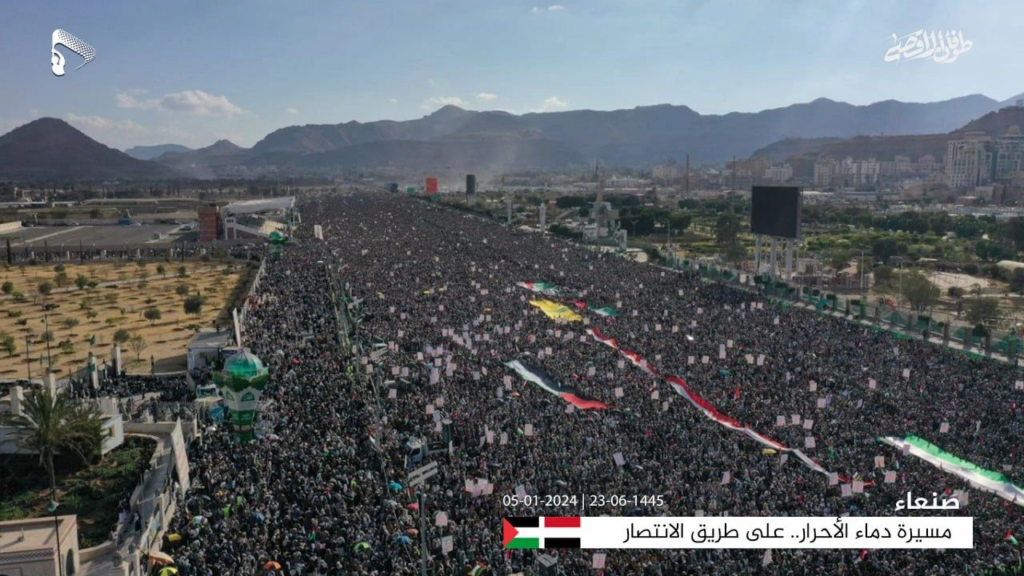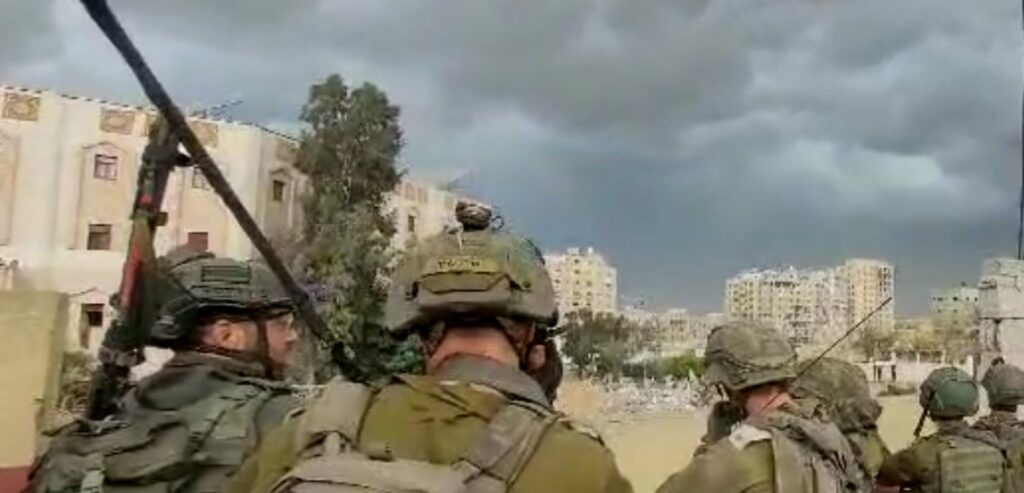Recent days in Israel’s multi-front war, mainly against Hamas in Gaza and Hezbollah in Lebanon, have been highly intense. These days contain several seemingly contradictory trends, which allow us to cautiously outline how the upcoming weeks could unfold, especially in terms of risks and opportunities at this juncture.
In Gaza, the IDF’s actions and statements by senior defense officials all indicate that Israel is moving to a third phase of fighting, with the first being waves of airstrikes and the second being a major ground offensive involving four divisions deployed across the Gaza Strip.
Rear Adm. Daniel Hagari, the IDF spokesman, made it abundantly clear on January 6 that developments in Gaza are what determine the transition between stages. He stated, “I would like to address issues raised in the media today regarding the transition between the stages of the war. A few days ago, I explained the IDF’s operations in the northern Gaza Strip and how we dismantled Hamas’ military framework in the north. While there are still terrorists and weapons in the north, they are no longer functioning within an organized military framework. We are now operating differently in that area, with a different mix of forces, to deepen our achievements. We are currently focusing on the central Gaza Strip, in the area of the central camps, and the southern Gaza Strip, in the area of Khan Yunis. This is still a complex operational activity, with hard battles being fought both in the center and the south. The fighting will continue into 2024.”
The release of the reservists thus occurring after the IDF made significant gains in the northern Gaza Strip.
The opportunity here for Israel is a decrease in international criticism, American pressure, and the ability to conduct more surgical operations. The dangers, on the other hand, could be higher risks to soldiers’ lives.
Another danger is the potential ‘Lebanonization’ of Gaza. Sinking into the Gazan quagmire and growing feelings in the Israeli public that the campaign’s timelines are extending, with the war’s objectives not yet being clearly met. Those primary goals are the return of the hostages, the elimination of Hamas leaders in Gaza, especially Yahya Sinwar, as a symbol of the war, and the barbaric mass murder assault on October 7.
The length of time it is taking to reach these objectives creates the risk of a sense of stagnation being felt among the Israelis, who continue to overwhelmingly support the war effort and the reaching of its state objectives.
In this context, it is important to note the recent letter sent by around 90 IDF battalion and deputy brigade commanders in reserve to the military Chief of Staff, Lt. Gen. Herzi Halevi, in which they ask to be allowed to continue in their mission to lead to Hamas’s collapse and defeat Hezbollah. They also call for military command to ensure that the war does not end with any sense of missed opportunities.
Meanwhile, sporadic rocket launches from the Gaza Strip continue, including towards central Israel and the town of Sderot, at a rate of dozens of rockets every week.
It was clear all along to Israeli military planners that this would take many months, but that does not eliminate the risk of a sense of stagnation spreading among the public. So, the manner in which the campaign is perceived versus the actual military achievements, of which there are many, is an issue that Israel’s military and political leadership will have to manage as the IDF enters phase 3 of its war plan.
In Lebanon, in recent weeks, we have seen a more proactive approach by the IDF that is no longer only focused on eliminating Hezbollah’s anti-tank missile-firing cells, which have been attacking northern Israeli communities daily. Instead, the IDF is now attempting to maximize achievements—striking Hezbollah until (or whether) a ceasefire is reached—without crossing the threshold into a full-scale war.
This includes targeted killings of senior figures in Hezbollah in south Lebanon and in Hamas within the Dahiya quarter, including the January 2 assassination of Hamas Deputy Politburo chief Saleh Al-Arouri in the Hezbollah-controlled Beirut quarter of Dahiya; the January 8 assassination of elite Hezbollah Radwan Unit commander Wassam Tawil, following an attack on an IAF Air Control Unit base, and the January 9 assassination of Hezbollah’s southern sector aerial unit, following an attack on IDF Northern Command Headquarters.
Hezbollah, predictably, is responding by increasing its firing ranges and trying to hit larger IDF bases. So far, despite the damages sustained and the sense of an escalation of these events, it is impossible to assess what the real breaking point will be.
Simultaneously, there is growing international pressure to reach a ceasefire in the North, and it seems that all sides see the connection between the North and the South.
In just the last two weeks, the following have visited the area: the French Minister of Foreign Affairs, Catherine Colonna, U.S. Special Presidential Envoy, Amos Hochstein, the French Defense Minister, Sebastien Lecornu, and U.S. Secretary of State Antony Blinken, who is, at the time of this writing, visiting Israel.
Hezbollah chief Hassan Nasrallah himself makes this connection, having stated clearly that he would not stop the fire without a ceasefire in Gaza. While the international system is trying to find “solutions” in the form of ceasefires in both arenas.
Within Israel, operationally, a different kind of connection is also clear. One of the advantages of reducing the intensity of the operation in Gaza is that it creates higher readiness levels on the northern front by freeing up military resources.
The main danger here is a diplomatic arrangement that does not lead to the dismantling of Hezbollah’s military capabilities in southern Lebanon, allowing it to continue threatening residents of Israel’s north.
As of today, more than 80,000 people have been evacuated from about 30 Israeli communities in the Lebanon border area (upper Galilee). Out of them, 60,000 have been displaced on government evacuation orders. If there is no assurance that Hezbollah’s capabilities to carry out a massacre, like the one that occurred on October 7th, have been neutralized, many will not return to their homes.
In fact, those who have the economic ability will likely not return, and the northern region will be harmed not only security-wise but also economically, socially, and in terms of future prospects. This will have implications even for communities that have not been evacuated.
Another risk emerging here is that a unique opportunity to deal with Hezbollah’s strategic capabilities will be missed, and Hezbollah will quickly recover from Israel’s limited attacks. In this scenario, Israel will pay the price that Lebanon demands within a diplomatic agreement, namely, withdrawal from the Shebaa Farms and Northern Ghajar (while it’s unclear what will happen to its Israeli inhabitants). Meanwhile, there will be no security for residents of the north.
On the other hand, the measured campaign that the IDF is conducting in the North creates an opportunity in that Israel could, below the threshold of a full-scale war, strike Hezbollah in southern Lebanon and at least lead to an improved security reality regarding threats from southern Lebanon. This scenario does not include the neutralization of the strategic Hezbollah rocket and missile array. Moreover, in this scenario, it is difficult to predict the point that limited attacks will escalate to a full-scale war.
Meanwhile, we cannot ignore what is occurring in the rest of the Middle East. The Houthis continue their naval blockade and extortion campaign, and just on Friday, there was a million-strong demonstration in Sana’a, Yemen, under banners stating, “Death to America” and “A course upon the Jews,” the same slogans seen in the funerals of Hezbollah terror operatives in Lebanon.

In Syria and Iraq, Shi’ite militias have continued to attack American forces on a daily basis since the beginning of the war—more than 110 attacks and counting, while American responses number less than ten.
Simultaneously, Iran, the architect and mastermind behind this entire campaign, senses no danger to itself. Last week, there was even a UN discussion about the disturbing progress Iran is making in its nuclear program.
On December 26, the U.N. nuclear watchdog, the IAEA, said Iran reversed a slowdown in its uranium enrichment at the level of 60% purity, which is close to weapons-grade (90%), enriching at a rate of around 9 kg a month from the previous rate of 3 kg.
“The IAEA confirmed that Iran had increased the production of UF6 (uranium hexafluoride) enriched up to 60% U-235 to about 9 kg per month at these two facilities combined since the end of November,” the IAEA said, referring to the enrichment sites in Fordow and Natanz, Iran.
The Western media reports claiming that Iran is not interested in war are at best misleading and at worst indicate a lack of understanding of the chess game we are experiencing here. Iran initiated the war, but as long as it can use Arab blood (Palestinian or Lebanese) and not conduct this war on its territory, it will continue along this modus operandi. Under these conditions, French and American ministers and advisors travel throughout the region, seeking to create diplomatic solutions to problems that would only grow worse under the very proposals they make.






